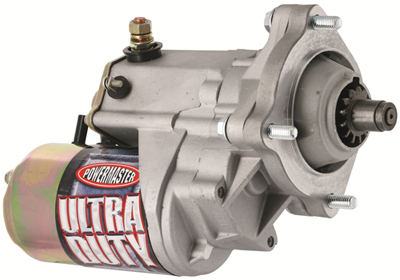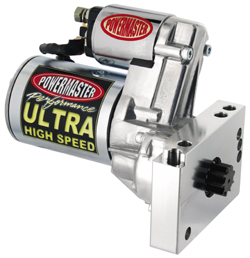 (More
tech articles on the Tech, Tests & Installs page
HERE) (More
tech articles on the Tech, Tests & Installs page
HERE)
Publisher's
note: I was on the website of our friends at Powermaster
Performance, makers of racing alternators and
starters, and saw this very informative article that
I thought would be helpful to share with you here.
 CHOOSING
A STARTER CHOOSING
A STARTER
1)
Torque Requirements
The torque output of a starter is the most important
consideration. The starter must be able to spin the
engine, and do it without overheating internally. Since
there is no such thing as having too much torque -even
on a street vehicle - a 200 ft.lb. starter will work
for everyone. Speaking in general terms, a over 12:1
compression or higher engine should use a 200 ft.lb.
starter. Engines up to 12:1 should use at least a 180
ft.lb. starter. 160 ft.lb. starters are good for engines
up to 10.5:1.
One
thing to keep in mind is that the torque characteristics
of a starter are a function of its design. High voltage
batteries or low internal resistance batteries will
affect the kilowatt output of the starter by changing
the output speed but not the torque. Therefore, buy
enough torque to begin with.
2) Fit
Of course for a starter to work, it must fit the application.
Consider headers, oil pans, and the mounting points
on the engine. What size ring gear do you have (for
Chevy applications)? Does your Chevy block accommodate
a straight mount starter, or is the only pattern drilled
in the engine block for a diagonal or offset pattern
starter? In racing, did the oil pan manufacturer lock
you into a particular shape of starter? In your Ford
application, is your ring gear 3/8” from the engine
plate - indicating a typical manual transmission starter
- or is it closer to a 3/4” - requiring a typical
auto transmission unit? How tight are the headers around
the starter? These are just some of the questions that
will help you determine the right starter for your application.
3)
Weight
Lastly,
depending on the form of racing, the overall weight
of the starter is a consideration.
TORQUE
DEFINED:
Torque
is the ability to overcome rotational resistance. High
compression, large displacements, tight rings, blowers,
and other factors all offer rotational resistance -
and it takes torque to overcome this. Unfortunately,
starters are rated in kilowatts. This is a measure of
its torque and speed combined. The torque output is
really unknown.
Starters,
like engines, have different powerbands. Some have a
maximum power point at a relatively high RPM with little
torque. Whereas others produce more torque and yet lower
RPM. In the performance environment, torque is the most
important consideration, generally because a performance
engine offers more rotational resistance than stock.
As a result, kilowatt ratings can be confusing because
two starters with the same kilowatt rating can have
very different torque characteristics.
 The
engine will demand a certain amount of torque for cranking.
When the torque demands cause a starter to exceed its
maximum power point, the extra input energy is wasted
as internal heat. Asking a starter to produce more torque
than it is comfortable with results in low electrical
to mechanical efficiency and drastically increased internal
heat. This is what causes premature starter failure.
The key is to use a starter that has a power peak at
a high torque point. Then, in the event that the cranking
conditions offers high resistance, the starter will
have the torque characteristics to handle it without
overheating. The
engine will demand a certain amount of torque for cranking.
When the torque demands cause a starter to exceed its
maximum power point, the extra input energy is wasted
as internal heat. Asking a starter to produce more torque
than it is comfortable with results in low electrical
to mechanical efficiency and drastically increased internal
heat. This is what causes premature starter failure.
The key is to use a starter that has a power peak at
a high torque point. Then, in the event that the cranking
conditions offers high resistance, the starter will
have the torque characteristics to handle it without
overheating.
Several
other factors effect starter performance dramatically.
Voltage is very important. Cabling and quality disconnect
switches are important because under heavy load, voltage
will be lost or "dropped" in undersized or
hot cables, or hot switches. The internal resistance
of the battery itself results in decreased voltage to
the starter. Therefore, low internal resistance batteries
like typical 1000CCA - or better yet - spiral cell AGM
batteries such as Optima and others should be used.
High voltage batteries like the new 16 Volt Powermaster
battery is a perfect choice for any racing application.
When
you purchase a Powermaster starter you will get a dyno
sheet that shows you the exact performance of your starter.
The sheet itself will explain how to interpret the data,
but you can be assured that Powermaster starters are
built to a consistent, statistically controlled standards,
and that they are dynamically tested throughout their
entire power range.
|
|
Source:
Powermaster Performance
www.PowermasterPerformance.com |
Dragtime
News On Location |
Tech,
Tests & Installs |
Bracket
Racing 101 |
|
|
Visit
the Tech,
Tests & Installs main page. |
Visit
the Bracket
Racing 101 main page.
|
|
|
|
|
|
 |

